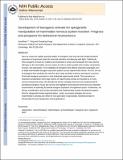Development of transgenic animals for optogenetic manipulation of mammalian nervous system function: Progress and prospects for behavioral neuroscience
Author(s)
Feng, Guoping; Ting, Jonathan Thomas
DownloadFeng_Development of.pdf (839.7Kb)
PUBLISHER_CC
Publisher with Creative Commons License
Creative Commons Attribution
Terms of use
Metadata
Show full item recordAbstract
Here we review the rapidly growing toolbox of transgenic mice and rats that exhibit functional expression of engineered opsins for neuronal activation and silencing with light. Collectively, these transgenic animals are enabling neuroscientists to access and manipulate the many diverse cell types in the mammalian nervous system in order to probe synaptic and circuitry connectivity, function, and dysfunction. The availability of transgenic lines affords important advantages such as stable and heritable transgene expression patterns across experimental cohorts. As such, the use of transgenic lines precludes the need for other costly and labor-intensive procedures to achieve functional transgene expression in each individual experimental animal. This represents an important consideration when large cohorts of experimental animals are desirable as in many common behavioral assays. We describe the diverse strategies that have been implemented for developing transgenic mouse and rat lines and highlight recent advances that have led to dramatic improvements in achieving functional transgene expression of engineered opsins. Furthermore, we discuss considerations and caveats associated with implementing recently developed transgenic lines for optogenetics-based experimentation. Lastly, we propose strategies that can be implemented to develop and refine the next generation of genetically modified animals for behaviorally-focused optogenetics-based applications.
Date issued
2013-03Department
Massachusetts Institute of Technology. Department of Brain and Cognitive Sciences; McGovern Institute for Brain Research at MITJournal
Behavioural Brain Research
Publisher
Elsevier
Citation
Ting, Jonathan T., and Guoping Feng. “Development of Transgenic Animals for Optogenetic Manipulation of Mammalian Nervous System Function: Progress and Prospects for Behavioral Neuroscience.” Behavioural Brain Research 255 (October 2013): 3–18.
Version: Author's final manuscript
ISSN
01664328